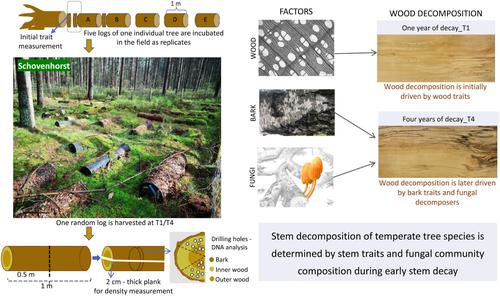Our official English website, www.x-mol.net, welcomes your feedback! (Note: you will need to create a separate account there.)
Stem decomposition of temperate tree species is determined by stem traits and fungal community composition during early stem decay
Journal of Ecology ( IF 5.5 ) Pub Date : 2024-03-26 , DOI: 10.1111/1365-2745.14295 Shanshan Yang 1, 2 , Lourens Poorter 1 , Frank J. Sterck 1 , Johannes H. C. Cornelissen 3 , Richardus S. P. van Logtestijn 3 , Eiko E. Kuramae 4, 5 , George A. Kowalchuk 5 , Mariet M. Hefting 3, 5 , Leo Goudzwaard 1 , Chenhui Chang 6 , Ute Sass‐Klaassen 1, 7
Dead trees are vital structural elements in forests playing key roles in the carbon and nutrient cycle. Stem traits and fungal community composition are both important drivers of stem decay, and thereby affect ecosystem functioning, but their relative importance for stem decomposition over time remains unclear. To address this issue, we used a common garden decomposition experiment in a Dutch larch forest hosting fresh logs from 13 common temperate tree species. In total, 25 fresh wood and bark traits were measured as indicators of wood accessibility for decomposers, nutritional quality and chemical or physical defence mechanisms. After 1 and 4 years of decay, we assessed the richness and composition of wood‐inhabiting fungi using amplicon sequencing and determined the proportional wood density loss. Average proportional wood density loss for the first year was 18.5%, with further decomposition occurring at a rate of 4.3% year−1 for the subsequent 3 years across tree species. Proportional wood density loss varied widely across tree species in the first year (8.7–24.8% year−1 ) and subsequent years (0–11.3% year−1 ). The variation was directly driven by initial wood traits during the first decay year, then later directly driven by bark traits and fungal community composition. Moreover, bark traits affected the composition of wood‐inhabiting fungi and thereby indirectly affected decomposition rates. Specifically, traits promoting resource acquisition of the living tree, such as wide conduits that increase accessibility and high nutrient concentration, increased initial wood decomposition rates. Fungal community composition, but not fungal richness explained differences in wood decomposition after 4 years of exposure in the field, where fungal communities dominated by brown‐rot and white‐rot Basidiomycetes were linked to higher wood decomposition rate. Synthesis : Understanding what drives deadwood decomposition through time is important to understand the dynamics of carbon stocks. Here, using a tailor‐made experimental design in a temperate forest setting, we have shown that stem trait variation is key to understanding the roles of these drivers; initially, wood traits explained decomposition rates while subsequently, bark traits and fungal decomposer composition drove decomposition rates. These findings inform forest management with a view to selecting tree species to promote carbon storage.
中文翻译:

温带树种的茎分解由早期茎腐烂过程中的茎性状和真菌群落组成决定
死树是森林中重要的结构元素,在碳和养分循环中发挥着关键作用。茎性状和真菌群落组成都是茎腐烂的重要驱动因素,从而影响生态系统功能,但随着时间的推移,它们对茎分解的相对重要性仍不清楚。 为了解决这个问题,我们在荷兰落叶松森林中进行了常见的花园分解实验,其中有来自 13 种常见温带树种的新鲜原木。总共测量了 25 种新鲜木材和树皮特征,作为木材分解剂可及性、营养质量以及化学或物理防御机制的指标。经过 1 年和 4 年的腐烂后,我们使用扩增子测序评估了木材栖息真菌的丰富度和组成,并确定了木材密度损失的比例。 第一年木材密度平均损失比例为 18.5%,进一步分解发生率为 4.3%−1 接下来的 3 年跨树种。第一年,不同树种的木材密度损失比例差异很大(当年为 8.7-24.8%)−1 )和随后的年份(0–11.3%−1 )。这种变化是由第一个腐烂年份的初始木材特征直接驱动的,然后是由树皮特征和真菌群落组成直接驱动的。此外,树皮性状影响木材栖息真菌的组成,从而间接影响分解速率。具体来说,促进活树资源获取的特征,例如增加可及性和高营养浓度的宽管道,增加了木材的初始分解率。真菌群落组成而非真菌丰富度解释了在野外暴露 4 年之后木材分解的差异,其中以褐腐病和白腐担子菌为主的真菌群落与较高的木材分解率有关。 合成 :了解随着时间的推移驱动枯木分解的因素对于了解碳库的动态非常重要。在这里,我们在温带森林环境中使用量身定制的实验设计,表明茎性状变异是理解这些驱动因素的作用的关键;最初,木材特征解释了分解率,随后,树皮特征和真菌分解剂成分驱动了分解率。这些发现为森林管理提供了信息,以选择树种来促进碳储存。
更新日期:2024-03-26
Journal of Ecology ( IF 5.5 ) Pub Date : 2024-03-26 , DOI: 10.1111/1365-2745.14295 Shanshan Yang 1, 2 , Lourens Poorter 1 , Frank J. Sterck 1 , Johannes H. C. Cornelissen 3 , Richardus S. P. van Logtestijn 3 , Eiko E. Kuramae 4, 5 , George A. Kowalchuk 5 , Mariet M. Hefting 3, 5 , Leo Goudzwaard 1 , Chenhui Chang 6 , Ute Sass‐Klaassen 1, 7
Affiliation

|
中文翻译:

温带树种的茎分解由早期茎腐烂过程中的茎性状和真菌群落组成决定



























 京公网安备 11010802027423号
京公网安备 11010802027423号